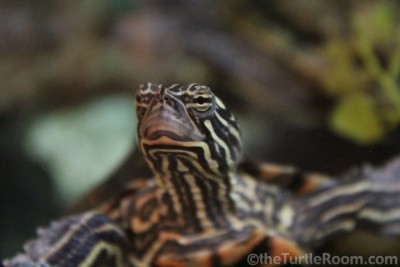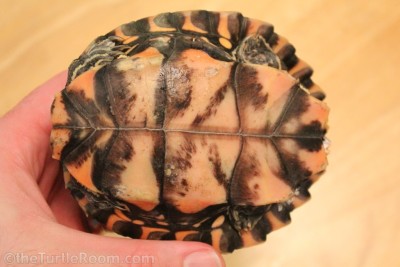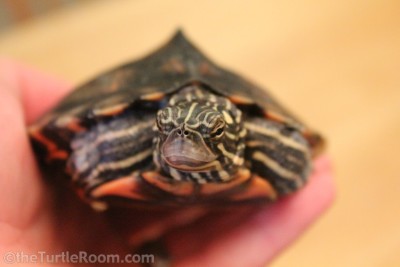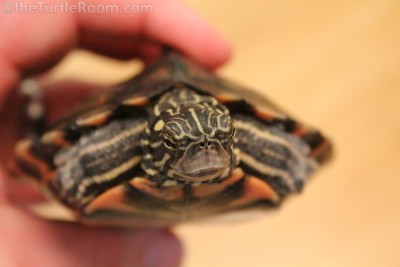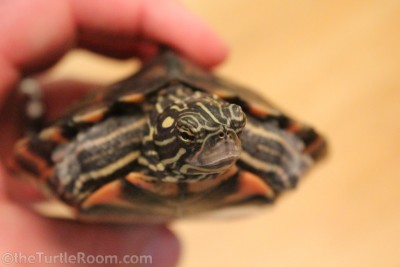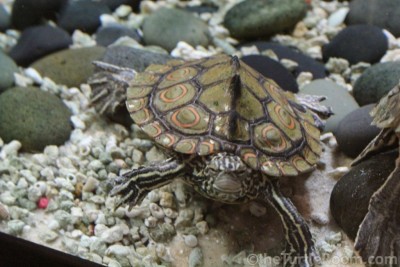Description and Identification
Graptemys oculifera is among the smallest of the map turtles. Males will only reach 2.8"-4.3" (7.2-10.9cm) SCL, mean 3.5" (8.9cm), max 4.3" (10.9cm), while females will typically reach about 5.1”-8.5" (13-21.5cm) SCL, mean 6.2" (15.6cm), max 8.6" (22cm). The carapace is light to dark olive green. It is moderately keeled with spine-like projections on the first 4 vertebrals which become less pronounced with age and the posterior edge of the carapace is mildly serrated. The primary identifying feature is the series of well-defined yellow to orange rings, one on each pleural scute. The dorsal surface of marginal is marked with a broken circle, semi-circle or bar. There may be a small spot in the center of these markings, particularly in juveniles. The plastron can have great variation. Its base is yellow with varying amounts of dark patterning along the seams. The skin of G. oculifera is black with yellow markings. There are variable post-orbitals (one behind each eye) that are oval, rectangular, or round in shape. They are usually not connected with the longitudinal dorsal stripes from the neck (though it does occasionally happen). The chin and throat are marked with broad longitudinal stripes and a transverse bar ("chin-strap"). Males will have narrow heads, slightly elongated foreclaws and longer, wider tails with the cloacal opening 1/2 to 2/3 of the way down the tail and a more juvenile appearance. Females will have shorter, narrower tails and a slightly bulkier build, including their heads.
-
 Primary ID: Bold rings on each pleural (can be muted, especially in adult females)Primary ID: Bold rings on each pleural (can be muted, especially in adult females)
Primary ID: Bold rings on each pleural (can be muted, especially in adult females)Primary ID: Bold rings on each pleural (can be muted, especially in adult females) -

-

-
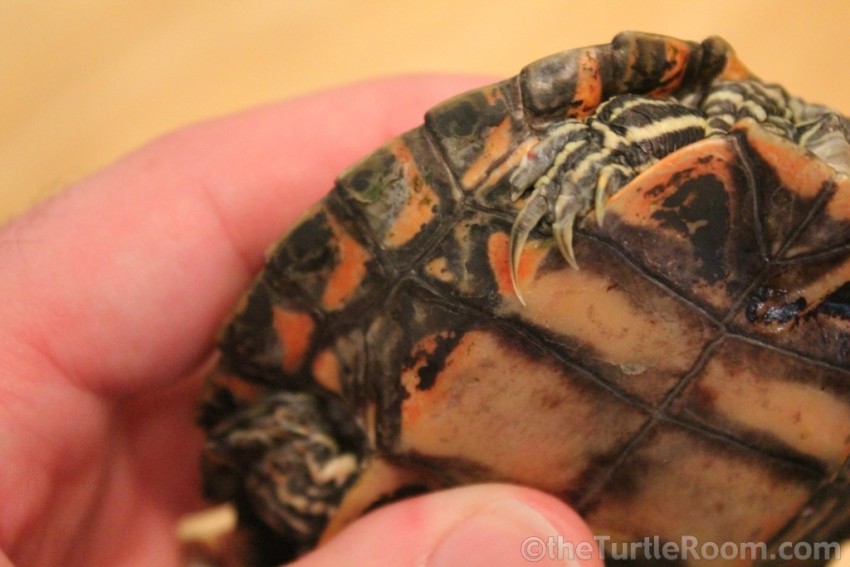
-

-

-

-

-

-

-

-

-

-

-

-

-

-

-

-

Distribution
The Ringed Map turtle is native to the Pearl River watershed of Mississippi and Louisiana. It occurs mainly in the Pearl River and its largest tributary, the Bogue Chitto River. It occasionally appears in some of the smaller tributaries.
Native Habitat
The habitat of G. oculifera has moderate to fast currents and contains a multitude of basking logs, sandbars, and a wide channel to allow sunlight in for most of the day. The river bottom of their preferred habitat is composed of clay, sand and/or gravel.
Wild Diet
The most common dietary item for the Ringed Map Turtle is insects and insect larvae. Small snails are also consumed. Plant matter is a very small portion of their diet; most plant matter consisted of flowers of the Asteracaea (Aster/Daisy/Sunflower) family or seeds resembling a frequently eaten beetle species. They will also feed on algae and other items growing on submerged logs.
Behavior
Very little information is available on the daily behavior of G. oculifera. It is diurnal and spends many hours basking. While basking, they are skittish and difficult to approach without spooking them. Upon being startled, they will dive into the water immediately. Hatchlings have also been known to bask frequently. At night, they tend to rest just under the waterline on various surfaces offshore.
Reproduction
Male Ringed Maps become sexually mature at approximately 2.6” (6.5cm) PL. The minimum SCL of females at maturity is approximately 5.1” (13cm), but is normally closer to 5.5” (14cm). Nesting season typically runs from mid-May through mid-July with a clear peak in mid-June. They lay most often during daylight hours before noon. Eggs are normally deposited on sandbars. G. oculifera typically lays only 1 clutch per year (.96-1.42) of 1-10 eggs, with an average of 3-4 eggs. The species is reported to demonstrate TSD-1a like the rest of the Graptemys genus. A pivotal IT of between 84.2-86F (29-30C) has been reported. No description of courtship or mating is available, but they are assumed to be similar to the normal methods used by many of the Graptemys species.
This Care Guide is an external Care Guide. While it is possible this care guide may not be for the exact species you were looking for, it provides information suitable for your species. This Care Guide link will take you away from theTurtleRoom. We only link to care guides we trust. Thanks for visiting theTurtleRoom.org.
Care GuideIf you would like to contribute to the photo gallery of any turtle or tortoise species, please email us at [email protected]. You will be credited for any photos you contribute.
| Graptemys oculifera |
| (Baur, 1890) |
| IUCN Red List: |
 |
| Vulnerable B2ab(iii) (2011) |
| Order: | Testudines |
| Suborder: | Cryptodira |
| Superfamily: | Testudinoidea |
| Family: | Emydidae |
| Subfamily: | Deirochelyinae |
| Genus: | Graptemys |
| species: | oculifera |
| Other Common Names: |
| Ringed Sawback |
| Old Taxonomy: |
| Malacoclemmys oculifera, Malaclemys lesueurii oculifera, Malaclemys oculifera, Graptemys pseudogeographica oculifera, Graptemys oculifera oculifera |
| CITES: | Appendix III |
| U.S. Legal Status: |
| ESA Listed, Take illegal in entire native range (Louisiana and Mississippi) |
Author:
Editors: Stephen J. Enders, Anthony Pierlioni, Chris Leone, Andrew S. Weber, Ben Forrest, and Andrew Hermes
Sources
Disclaimer: The Species Profiles - Natural History, Care Guide, and Photo Gallery database is an educational resource. It does not cover all Chelonian species in the world, nor does it include all the latest scientific information about the species covered. Though we edit our accounts for accuracy, we cannot guarantee all information in those accounts. While theTurtleRoom's staff and contributors provide references to books and websites that we believe are reputable, we cannot necessarily endorse the contents of references beyond our control.

This work by theTurtleRoom is licensed under a Creative Commons Attribution-NonCommercial-ShareAlike 4.0 International License.











